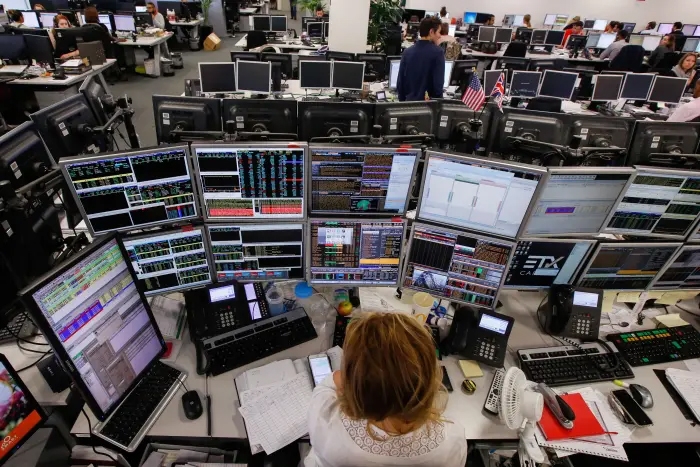
Risk sentiment is notably higher, driving up global equity markets, bond rates and commodity currencies, while the USD is the weakest of the majors.
After the long weekend in some countries, investors are feeling optimistic about the outlook, driving up equity prices. The S&P500 has blasted up through the 3000 level for the first time since early March and is currently up near-2%, following a more than 1% gain for the Euro Stoxx 600 index. For the S&P500, for a change IT and Health Care stocks are dragging the chain, with the rally led by Financials and economically-sensitive sectors such as Industrials and Materials, positive sign. In Europe, travel and leisure stocks led the gains in response to moves by Germany and Spain to lift their travel restrictions.
Investors seem encouraged by the easing of restrictions and reopening up of economies. Reports show demand soaring this month for vacation rentals in pockets of the US, while restaurant bookings and spending on hotels and airlines is also picking up. As another sign of normality returning, the NYSE trading floor reopened overnight.
Positive market sentiment comes as the daily death rate in the US from COVID-19 hovers at its lowest level in about two months, following declines in death rates in many other countries. Broker reports suggest that lockdowns are unlikely to be re-imposed, even if a second-wave of the virus develops. A UBS report noted the weak correlation between the severity of lockdowns and the spread of the virus while a JP Morgan report noted the reproduction rate of the virus hasn’t increased after the restrictions have been relaxed in countries including the US. The conclusions were that herd immunity was a factor, with many of the most vulnerable populations already exposed to the virus and measures unrelated to lockdowns – such as better contact tracing and increased measures to protect the most vulnerable – may be more effective in slowing the spread.
Investors are likely also encouraged by the resources being devoted to vaccine development. The top story on Bloomberg is China “throwing the might of the Chinese state behind the country’s vaccine developers”, with five vaccines currently being tests on humans, following the US programme called Operation Warp Speed to accelerate vaccine R&D. Competitive pressure to become the first country to produce a vaccine could help expedite its development.
Still, the road to a vaccine might still remain a long one, with the CEO of Merck casting doubt on the 12-18 month timeframe to develop an effective COVID19 vaccine, calling that “very aggressive” and “it is not something I would put out there that I would want to hold Merck to”, adding that vaccines should be tested in “very large” clinical trials that take several months if not years to complete. However, these comments don’t seem to have perturbed market optimism.
There has also been some encouraging news on the economic front. US consumer confidence ticked higher, suggesting signs of consolidation, after recently falling but not nearly as much as during the GFC, indicating some underlying resilience. New home sales were much stronger than expected and suggested a much shallower trough in homebuilding compared to many other indicators.
The risk-on vibe sees higher global rates, with the US 10-year Treasury yield up 4bps to 0.70%, following a rise in key European 10-year rates of 4-6bps.
There have been some notable moves in currency markets, with broadly-based USD weakness. The BBDXY index has broken down below support, to record a chunky 0.9% fall alongside a move to its lowest level since mid-March. At this stage the more widely followed DXY index is hanging in there near the 99 mark, with support a bit lower at 98.3.
With increased demand for risk-loving commodity currencies, the NZD has broken up through the first level of resistance of 0.6175 and through 0.62 as well, and is currently near its highs for the day and up about 2% for the day to about 0.6225, a level not seen since mid-March. This paves the way for further strength, although it remains to be seen whether the long-awaited demise of the USD is finally upon us.
The AUD has also been driven up to a multi-month high and trades this morning at 0.6670, roughly matching the gains of the NZD, seeing the NZD/AUD cross rate hover around 0.9330.
While EUR and GBP show decent strength against the USD for the day, GBP has done better, after underperforming through much of May. The BoE’s Chief Economist Haldane played down the prospect of negative interest rates, saying that policymakers weren’t ruling any options out “as a matter of principle”, adding that “reviewing and doing are different things”.
Higher risk sentiment sees JPY languish alongside the USD and USD/JPY barely lower at 107.60. NZD/JPY is up a chunky 1.8% for the day to 66.9.
NZ rates were higher across the curve yesterday, on the lead given by US Treasury futures. A faster than expected easing of restrictions for NZ – with a move to alert level 1 likely to come a lot earlier than envisaged even a couple of week ago – is also putting upside pressure on the short end of the curve, with the market anticipating less need for further RBNZ rate cuts. The 2-year swap rate rose by 3bps to 0.21%, while the 10-year rate rose by 5bps to 0.67%. The RBNZ’s Financial Stability Report will only be of passing interest today.

We welcome your comments below. If you are not already registered, please register to comment
Remember we welcome robust, respectful and insightful debate. We don't welcome abusive or defamatory comments and will de-register those repeatedly making such comments. Our current comment policy is here.